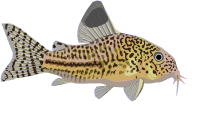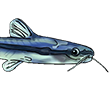| Scientific Name | Synodontis acanthoperca Friel & Vigliotta, 2006 |
| Common Name | Scissortail Syno |
| Type Locality | Ogôoué River at and below the rapids of Massoukou (Masuku), 1°39'30"S, 13°32'14"E, Haut-Ogôoué Province, Gabon. |
| Pronunciation | sin oh don tiss |
| Etymology | According to Cuvier, Synodontis is an "ancient name for an undetermined fish from the Nile". It is not derived, as often reported, from syn-, together and odous, tooth, presumed etymology of the lizardfish genus Synodus and refers to the closely-spaced lower jaw teeth of both genera. The specific name is a Latinized combination of the Greek acantha, meaning a thorn and the Latin opercul, meaning a cover or lid, alluding to the distinctive opercular spines developed by mature males in this species. |
| Size | 46mm or 1.8" SL. Find near, nearer or same sized spp. |
| Identification | All species in the genus Synodontis have a hardened head cap that has attached a process (humeral process) which is situated behind the gill opening and pointed towards the posterior. The dorsal fin and pectoral fins have a hardened first ray which is serrated. Caudal fin is always forked. There is one pair of maxillary barbels, sometimes having membranes and occasionally branched. The two pairs of mandibular barbels are often branched and can have nodes attached. The cone-shaped teeth in the upper jaw are short. S-shaped and movable in the lower jaw. These fish produce audible sounds when disturbed rubbing the base of the pectoral spine against the pectoral girdle. Synodontis acanthoperca is a relatively small species that can be distinguished from all congeners except Synodontis punu by a distinctive pigmentation pattern that includes a pair of dark patches on the caudal fin. One patch is present in the middle of each lobe of the fin. Furthermore, this species and also Synodontis punu are distinguished by the presence of a well developed opercular spine in sexually mature males. In all other mochokid species the opercle lacks such well-developed ornamentation and sexual dimorphism of the opercle is unknown. |
| Sexing | According to the original description, males have well developed opercular spines. |
| Distribution | Africa: Ogowe River in Gabon. African Waters, Gabon Waters, Ogowe (click on these areas to find other species found there) Login to view the map. |
| IUCN Red List Category | Data Deficient , range map and more is available on the IUCN species page. Last assessed 2009. |
| Breeding | Unreported. |
| Breeding Reports | There is no breeding report. |
| Reference | Zootaxa No. 1125, pp 47, Figs. 1-3. |
| Registered Keepers | There is no registered keeper. |
| Wishlists | Love this species? Click the heart to add it to your wish list. There is no wish to keep this species. |
| Spotters | Spotted this species somewhere? Click the binoculars! There is no record of this fish being seen. |
| Forum BBCode | |
| Search for S. acanthoperca | |
| Look up S. acanthoperca on AquaticRepublic.com | |
 | Look up S. acanthoperca on Fishbase |
 | Look up S. acanthoperca on Encyclopedia of Life |
 | Look up S. acanthoperca on Global Biodiversity Information Facility |
| LFS label creator ARN ref:1.13.29.2184 | |
| Last Update | 2025 Jan 02 00:42 (species record created: 2009 Jan 01 12:21) |





/siluriformes/mochokidae/synodontis/acanthoperca/1.jpg)
/siluriformes/mochokidae/synodontis/acanthoperca/2.jpg)
/siluriformes/mochokidae/synodontis/acanthoperca/3.jpg)